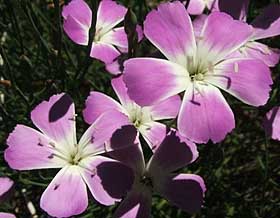Dianthus albens
Dianthus albens Aiton
Family: Caryophyllaceae
Common names: wild pink
Introduction
Many people think of Dianthus or carnations as cut flowers from places in Europe and very little is known about our very own indigenous species. Although the indigenous species do not compare in size or colour to their European relatives, they make an interesting and pretty addition to any South African garden. Providing mounds of pink flowers when most plants are going off, Dianthus albens makes quite a show.

Description
Description
Most South African species grow as small herbaceous plants but there are some which form moderately sized shrubs, and have small flowers with colours varying from white through to pink and salmon tones.

Dianthus albens is the only species which is sometimes cultivated and flowers over a fairly long period during the early summer months. It has fine leaves which grow from spreading stems along the ground. It usually flowers in late November and December. The seeds are black and flaky.
Conservation Status
Status
There is little concern over the conservation status of this species as it is fairly common.
Distribution and habitat
Distribution description
Dianthus albens is fairly common in coastal areas all along the Western Cape coastline, growing in rocky areas and even in sand dunes. Plants are normally only seen in flower as their leaves and stems are easily overlooked in the veld.
Ecology
Ecology
The seeds of Dianthus albens are dispersed by the wind.
Uses
Use
Dianthus albens can be used in a rock garden or it can be used as filler in the border for summer colour.

Growing Dianthus albens
Grow
Dianthus albens plants are easily grown from seed which should be harvested in midsummer and sown the following autumn. Sow the seeds thinly in a sandy mix and keep moist through the winter. When the seedlings are fairly large they can be planted out in the garden where they should flower by December or if not, the following year. Plants can also be grown from cuttings, which should be taken in autumn so they can grow through the winter before flowering in summer-this is a good way of obtaining larger plants more quickly. Plants should be grown in a sunny area in the garden and be watered moderately throughout the year. They are also not fussy about soil but will grow with more vigour in slightly richer, sandy soils.
References
- Maytham Kidd, M. 2002. Cape Peninsula. South African Wild Flower Guide 3: 48-50. Botanical Society of South Africa, Cape Town.
- Rice, E.G. & Compton, R.H. 1951. Wild flowers of the Cape of Good Hope.
Credits
Gary Shanks
Kirstenbosch National Botanical Garden
December 2008
Plant Attributes:
Plant Type: Perennial
SA Distribution: Northern Cape, Western Cape
Soil type: Sandy, Loam
Flowering season: Early Summer, Late Summer
PH: Acid, Alkaline, Neutral
Flower colour: White, Pink, Mauve/Lilac
Aspect: Full Sun
Gardening skill: Easy
Special Features:
Horticultural zones










Rate this article
Article well written and informative
Rate this plant
Is this an interesting plant?
Login to add your Comment
Back to topNot registered yet? Click here to register.